The aesthetics of the dentition care about humanity since the dawn of ancient civilizations. So, archaeologists have repeatedly turned their attention to the wrapped around the teeth of Egyptian mummies ropes made from the intestines of Pets.
According to them, this was the very first attempts of the healers to straighten crooked teeth.
Officially, the first braces were invented in 1728 by the French surgeon Pierre Fauchard. Structurally, they were a flat metal teeth, connected by a thin thread.
Modern braces have little in common with the ancient design. They are comfortable for the patient and effective so that orthodontists speak boldly about the movement of the tooth in any direction, including, and turning it around its axis.
What is the braces
Essentially, the braces are small locks, which are securely fastened to the surface of the tooth. For installation of braces dentists use a special glue, which releases fluorine, thereby, protecting the enamel from demineralization.
Interesting! Each bracket is designed for installation on a specific tooth, as its design is initially laid information about the correct orientation of the tooth in 3 dimensions.
Depending on what types of braces are chosen, the smile of a patient can look completely different. Someone chooses a classic metal option, someone agrees to the correction of the dentition only with one condition – if the braces are absolutely not noticeable to others. But Teens have long looked to the procedure of correcting the bite as another opportunity to Express their own individuality, and ask your doctor to set color or curly braces.
In any case, the braces are not correct dentition. They – only a part of a complex device, which is called the “bracket system”.
What are the braces
Their main element – an arc that has the correct form of the dentition. It moves your teeth to the desired position, constantly acting on them. The arc can be made of different alloys, have a round, square or rectangular cross-section. In the treatment process, the orthodontist replaces the arc is not less than 3-7 times, gradually moving from subtle to more severe.
In addition to the arc and braces system design includes:
- Alloys. Metal or made of an elastic material, they firmly fix the arch in the braces. Wear, and therefore replaced, alloys in the process of treatment often.
- Orthodontic locks or rings. This interchangeable elements, which are selected by the dentist depending on the clinical situation. The locks and rings are installed on the 6 and 7 teeth, and serve to support the arc.
- The elastics. Represent rings of elastic material, which when the faithful execution of instructions of a physician, allow the patient to correct the malocclusion. Their patient wears on their own, consolidating between the castle and the wings of the bracket. Because the elastics soiled and torn, need to change them 2 times a day.
- Hooks. This is an additional constructive element of the orthodontic lock, the ring or the bracket that allows you to hold the elastics.
When installing the system, the doctor secures the braces on each tooth. In their grooves is introduced to the orthodontic arc, which is fixed by means of ligatures or closed with a special lid, if it is provided by the design of the bracket. To fasten the whole structure to use the rings and cheek locks. The latter can be fastened directly on the tooth enamel and braces. And can be welded to the rings, covering the tooth and secured with cement. But sometimes this is not enough. And in the course are numerous accessories: chains, elastics, springs.
The principle of operation
The secret of braces lies in the orthodontic arc. No matter what material it is made, its main feature is the “memory”. Located on the far from perfect dentition, the arc always tends to return to its original shape. Slowly but surely, she drags the teeth, bringing them back to their “proper” place. At first the effect is subtle and more elastic arcs to the patient is accustomed to the constant impact. But over time, the doctor replaces arc more stringent.
Very often for making Doug an alloy of Nickel and titanium developed by NASA for the aerospace industry. This material is able to fully recover its shape even after it is bent and fix the braces on the tooth surface.
The process of tooth movement possible due to the structure of our jaw. The fact that the teeth in the hole is not adherent to the bone, but only fixed by connective tissue fibers. And if the wall of the hole to put a little pressure, this is where the bone tissue begins to dissolve. The tooth will change its position. And in place of stretching the connective tissue gradually forms a new bone, which will harden the tooth at the new location.
Of course, this is not a quick process! Braces the patient will have to wear for at least a year. And in some cases treatment may last about 3 years. All this time the patient should regularly visit a doctor and strictly adhere to its recommendations. But after removing the system to relax early: retention period, which will consolidate the results of treatment can last for about 2 years. All this time the patient will have to wear retainers, the devices that hold the teeth in proper position.
To wear retainers after removing the braces accounts for 25% of patients. And in the most difficult cases, retainers will need to wear at night the rest of my life.
Metal braces
The most affordable, but because it is still the most popular. Their price starts with a mark of 15 000 rubles per 1 dentition. Alas, to call metal braces aesthetic does not, although colored alloys partially solve this problem.
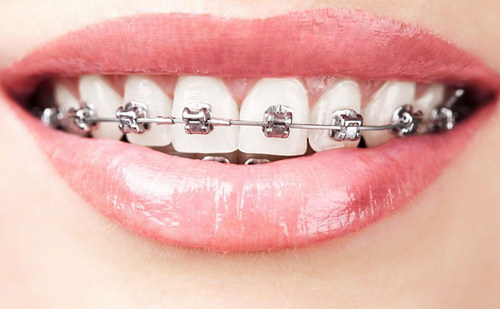
But, if teenagers such option and may make, adults still prefer to occlusion treatment remains invisible to others. And manufacturers of orthodontic systems are reluctant to meet them: already today you can buy metal braces with white Teflon coating.
Have metal braces and benefits. They are reliable, durable, have a small size which is very convenient for the patient. In addition to all-metal system used is very simple: discomfort will be felt only for the first 2-3 days.
Interesting! A metal structure similar to that of modern dental braces worn by the soldiers of Brittany in the 18th century. Her task was to save the teeth of the fighter during serious fights with rivals.
Ceramic braces
It is their most often choose public people: actors, politicians, teachers. Ceramic braces are made individually for each patient from ceramic, so the color completely matches the shade of the enamel, and notice the similar design is possible only at close range.
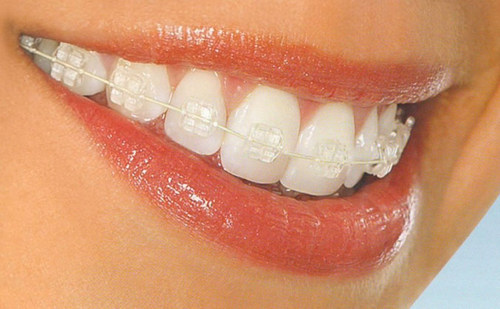
For “invisible” correction 1 of the dentition will have to pay a minimum of 20 000 rubles. That’s just to go with ceramic braces is care: they are afraid of strong loading, which can crack, and can not tolerate cigarette smoke after 1-2 weeks, the smoker can see that it braces much darkened.
Setting system with ceramic elements, also is to abandon colored soft drinks, coffee, red wine, spices such as saffron or brown. Otherwise the braces will not disappoint: they are quite durable and are of a rounded form, so it does not injure the mouth.
Plastic braces
In some cases, for short-term treatment the orthodontist can offer the installation of plastic braces.
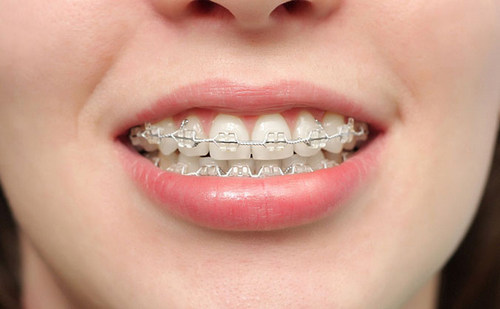
The cost is an average of 10 000 rubles for 1 tooth row, which makes this system the most affordable among all. Alas, the plastic braces are fragile and short-lived. And they are easily painted with cigarette smoke, berries and colored drinks.
Sapphire braces
At first glance, the sapphire braces are very similar to ceramic. They are also barely noticeable and aesthetically pleasing as they are completely transparent. Braces are made from artificially grown sapphire, which, although inferior in strength to the metal, but much superior ceramics.
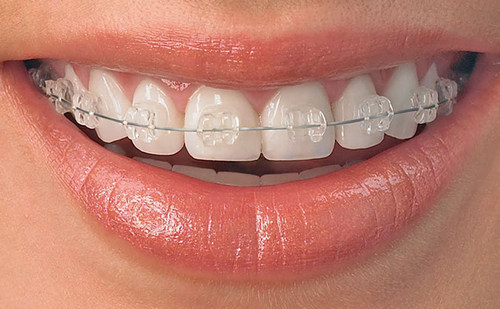
To other positive properties of sapphires can be attributed to their hypoallergenic and the ability to sparkle in the light that pleases many patients dentists. These braces require careful maintenance, but it ensures no problems with diction. Sapphire braces are the most expensive among transparent systems: to install it 1 tooth row, will have to spend at least 25 000.
75% of patients, orthodontists have not reached 18 years of age. But the use of braces for the correction of smile can be 30, 40, and even 50 years. Today all over the world wear plate, approximately 10 million people!
Titanium braces
If the patient is prone to allergic reactions, he was diagnosed with chronic disorders of the gastrointestinal tract, any orthodontist will first recommend him to install titanium braces. They cost about 20 000 rubles for 1 dentition.
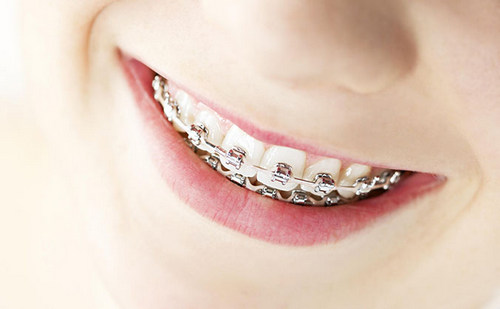
Titanium, in contrast to Nickel, which is part of the offices of steel, the material is biocompatible, that is, absolutely safe for humans. That is why it is often used to create dental implants because the risk of rejection or inflammation in the oral cavity is minimal. Other advantages of Titan systems include their lightness and strength, reliability and durability. But the drawback of such braces, one of their visibility.
Combination braces
Installation of braces, and especially aesthetic “systems-invisible” can be quite expensive. Therefore, many clinics offer their clients to install in the smile zone (6 front teeth) invisible braces made of sapphire or ceramic, and chewing teeth to secure the metal elements.

So the patient will be able to save a few thousand rubles, and will not feel awkward while smiling. Unfortunately, this option is not for everyone: if the wide smile, then metal elements will still be visible. In addition, the combined system of complex care, and the patient should be ready in the first weeks of his diction will be broken.
Types of braces according to the location on the teeth
The dentition of man has 2 surfaces: the outer (vestibular) and inner (lingual). Depending on which of them will face pressure orthodontic system, and secrete 2 types of braces.
Vestibular braces (outside)
It’s traditional fixed structures, which are installed on the outer side of the teeth. They successfully cope with the task of alignment of the dentition and occlusion. To the vestibular braces patient gets used quickly – within a few days. They are wearing little appears in the diction and the care system itself is not complicated.
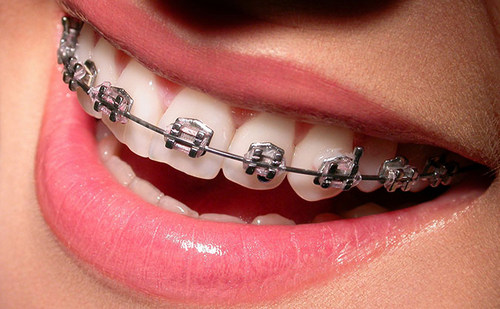
The last argument is decisive in pediatric dentistry: the young patients of the internal braces is contraindicated. Vestibular orthodontic system has only one obvious flaw – it’s too noticeable, as if dentists didn’t try to improve.
Lingual braces (internal)
Recently become available to Russian patients lingual system or “braces-invisible.” They are mounted on the inner side of the teeth and are completely invisible. That is why they are recommended for people that are very worried about the aesthetics of your smile.

Of course, the cost of installing of lingual braces is more expensive vestibular: from 30 000 rubles per 1 dentition. Yes, and to work with the internal system the orthodontist is more difficult: it requires knowledge and solid experience. Therefore, so far such a service can offer, not every dental clinic.
Braces on the inner surface of the tooth it is impossible to determine if the patient has front teeth shortened. In addition, such systems are unable to solve the serious problems with the bite.
“Braces-invisible” can bring severe discomfort and their holders: as practice shows, getting used to such systems, patients at least 1 week. And subsequently often complain of problems with diction and irritation of the tongue. In addition, lingual braces are more difficult to care for.
Types of systems the method of fixation
No less important indicator than the material of the braces and their placement in the oral cavity – a method to fix brackets to the power arc. Classic variant – ligature braces, in which the main role of elastic rings or metal wire ligatures. More modern and more widely advertised option is braces special clamps (zamocka).
Ligature braces
In the initial stages of treatment, the orthodontist applies most often clear or multi-colored bands of elastic material. But at the final stage of correction in the case are the wires made of aluminum, silver or steel.
Regardless of braces, during treatment the teeth will hurt. Especially the severe discomfort experienced by patients at the initial stage. The intensity of the pain depends on the individual characteristics of the organism. In some cases, patients are shown painkillers.
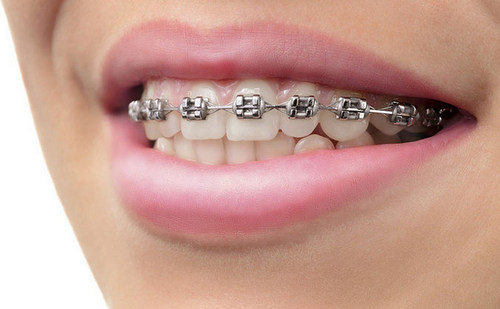
The advantages of the ligature of braces include:
- high efficiency. The most severe malocclusion can be corrected only using the classic braces;
- affordable cost;
- a guaranteed result.
Unfortunately, for all its efficiency, ligature braces have many drawbacks:
- procrastination often injure the inside of the lips and cheeks;
- elastic ring easily colored with food coloring and lose its original appearance;
- the tension of the rings quickly leads them into disrepair, and about once a month the patient will have to visit the dentist to replace the ligature;
- the correction process is rather painful due to the fact that the arc is fixed still;
- the design is bulky, and caring for it requires a lot of time.
But the teenagers will certainly appreciate the possibility to choose the color of your smile, because of the elastic ligature are made of all colors of the rainbow.
Self-ligating braces
To self-ligating or self-ligating braces arc is mounted by means of movable clamps. It can be door-bolts, latches or spring clips – it all depends on the design ideas of the manufacturer.
Interesting! The first self-ligating system was invented in the 70-ies of XX century. But the popularity of these braces found only at the beginning of the XXI century.
The main difference between self-ligating braces is that they are not fixed rigidly to the arc, and only block the ability to move it. So patients say that the pain such a system brings much less.

Among other advantages of self-ligating braces:
- compact;
- more easy maintenance;
- ease of installation system;
- faster correction process;
- minimal risk of damage to the mucous membranes in the process of wearing design. Due to this, self-ligating braces can be used even in patients with periodontal disease.
But especially the fact that self-ligating braces do not require the attention of a doctor. As a rule, visits to the orthodontist is limited to 1 time in 2-3 months. Have modern systems and disadvantages. This is a high price, which several times exceed the cost of the actual braces, and the inability to fix serious malocclusion.
Removable braces
There are such systems of correction of the malocclusion.
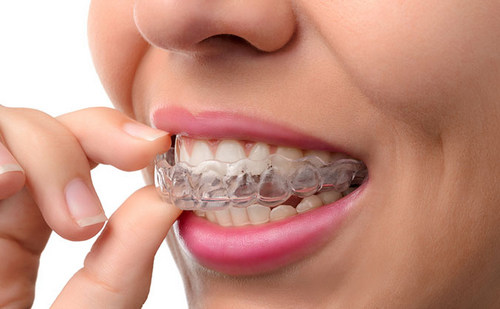
These include:
- trainers – devices that can shoot jaw tension;
- orthodontic plates – design created to correct the alignment of teeth and expansion of the dentition;
- the aligners. They represent a transparent claw caps, effective with minor deviations in the occlusion.
Most often, removable braces are recommended for children from 6 to 12 years. If the tooth row already formed, to change the situation with temporary construction impossible. Adult patients removable braces can be recommended to secure the result after the treatment by fixed systems. Such designs are 12-14 hours a day, often at night.
Association of orthodontists recommends that every child should be seen by a specialist no later than the attainment of 7 years. At this age it is already possible to foresee all possible problems with the bite, and begin treatment. At an early age it will be much easier.
Other varieties
Braces are constantly being improved. Rumor has it that today in the laboratories of Oxford in full tested magnetic designs. And who knows, maybe very soon such orthodontic systems will be available. And while the most unusual types of braces are colored, figured and intelligent.
Self-adjusting braces
More recently, the patient could only dream that the correction of the dentition will be fully individualized. This type of orthodontic equipment appeared. Self-adjusting braces are manufactured individually for each patient. Every item is programmed as it should stand in a particular tooth, and starting treatment, a client of the clinic knows exactly how his smile would look like in the end.
Self-adjusting braces can reduce the traumatic effect of the adjustment process of the dentition, and by 25% to reduce the total duration of treatment.
Curly braces
If the orthodontist insists on installing it metal ligature braces, there is a great opportunity to turn their main drawback is the visibility to others in the main highlight of her appearance. For this you just need to ask the dentist to install the curly braces in the form of stars, flowers or hearts. Such systems are popular among children and adolescents. They are durable, reliable and affordable.
Colored braces

Another way to transform the design for the correction of the dentition to a stylish accessory – set colored braces. A funny look they give elastic ligature. These braces are inexpensive, and because the alloys have to be changed often, they can experiment with their own smile.
What braces should I choose?
It is natural that choosing orthodontic system, which will have to live not less than one year, the patient to strive to opt for the best.
In this case, dentists are advised to pay attention to the leaders of orthodontics:
- Ormco is the most well-known American company, which produces braces, since the 50-ies of the last century. Today, the company specializiruetsya on steel, titanium and ceramic bracket systems;
- Forestadent company from Germany, which can be proud of what her metal braces community dentists recognized as the most common and popular design in the world. Today the product range of the company completed and lingual bracket systems.
- Top Service – German laboratory, known for its revolutionary system correction of malocclusion, Incognito. It is slim, comfortable lingual braces, are completely invisible to others.
And yet, orthodontists agree that the selection system is only half the story: competent doctor will achieve a great result even with the standard system, and inexperienced dentist can simply not cope with complex programmable braces. In addition, to recommend a particular structure is meaningless without seeing the patient. But because the most important thing is to find a doctor whom you can trust 100%. And together with him decide what braces will help you achieve the perfect smile.
Contraindications to the installation of braces
Absolute contraindications for the installation of braces include:
- blood diseases: anaemia, leukaemia;
- some pathology of the cardiovascular system;
- cancer;
- acute immunodeficiency States;
- pathology of bone tissue;
- mental disorders;
- epilepsy;
- tuberculosis;
- diabetes.
Also, the orthodontist may refuse the patient if gums or your teeth require treatment. In this case, the malocclusion it is necessary to wait, and to do, first and foremost, the health of the oral cavity.
Not all the myths about braces are true. So, it is impossible to catch them while kissing. The bracket system does not increase the patient’s chances of being struck by lightning. It also doesn’t hurt sports and playing musical instruments.

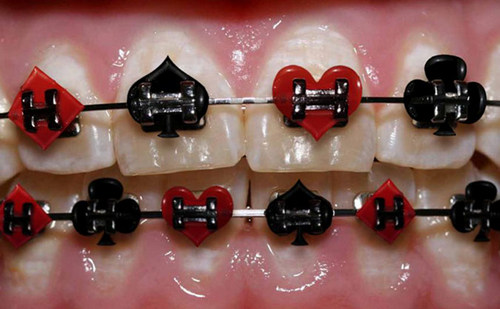

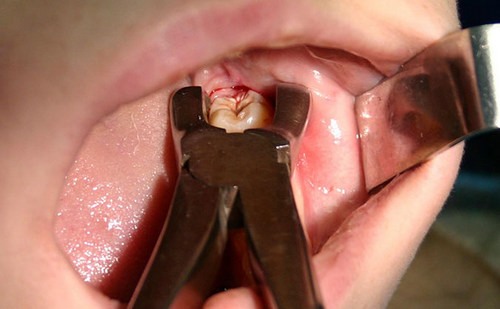

Hey There. I found your blog using msn. This is an extremely well written article. I’ll make sure to bookmark it and return to read more of your useful info. Thanks for the post. I’ll definitely comeback.
One more issue is that video gaming has become one of the all-time most significant forms of entertainment for people of various age groups. Kids have fun with video games, and also adults do, too. The XBox 360 has become the favorite video games systems for those who love to have a lot of video games available to them, along with who like to play live with others all over the world. Many thanks for sharing your notions.
You should seriously blog daily. This is awesome. Hell, blog twice a day. I love reading this kind of content.